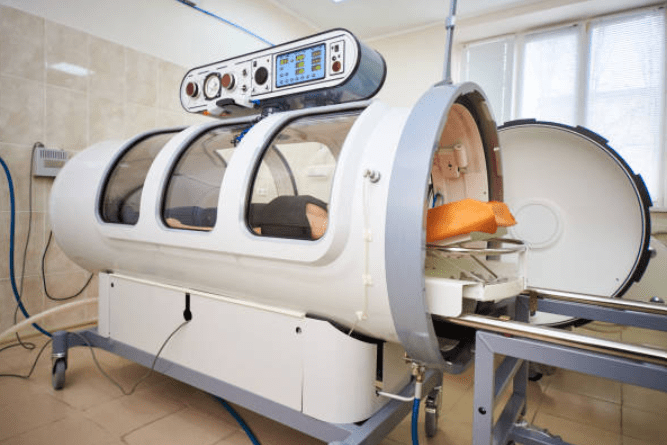In the realm of medical treatments, there are constantly emerging technologies and therapies designed to enhance the body’s natural healing processes. One such therapy that has gained considerable attention in recent years is hyperbaric oxygen therapy (HBOT).
This innovative treatment involves exposing the body to high levels of oxygen in a pressurized environment, leading to a range of potential health benefits. In this comprehensive exploration, we delve into the intricacies of hyperbaric oxygen therapy, examining its mechanisms of action, applications across various medical conditions, and the potential for future developments.
Understanding Hyperbaric Oxygen Therapy: The Basics
Before delving into its benefits, it’s essential to grasp the fundamental principles of hyperbaric oxygen therapy. At its core, HBOT involves breathing pure oxygen in a pressurized chamber, typically at pressures higher than atmospheric pressure at sea level.
This increased pressure allows the lungs to gather more oxygen than would be possible under normal conditions, subsequently enhancing the oxygen supply to all tissues and organs in the body.
The Mechanics Behind HBOT
The efficacy of hyperbaric oxygen therapy lies in its ability to increase the oxygen concentration in the bloodstream, leading to a range of physiological effects. Under normal circumstances, oxygen is transported throughout the body by red blood cells, primarily bound to hemoglobin.
However, during HBOT, oxygen dissolves directly into the plasma, reaching areas where circulation may be compromised, such as damaged tissues or areas with reduced blood flow.
Applications Across Medical Conditions
Hyperbaric oxygen therapy has demonstrated remarkable versatility in treating various medical conditions, ranging from chronic wounds to neurological disorders. Below, we explore some of the key areas where HBOT has shown promise:
- Wound Healing and Tissue Repair: One of the most well-established applications of HBOT is in wound healing and tissue repair. By increasing oxygen delivery to damaged tissues, HBOT promotes angiogenesis, collagen synthesis, and microbial killing, facilitating the healing process in conditions such as diabetic ulcers, burns, and non-healing wounds.
- Carbon Monoxide Poisoning and Gas Embolism: HBOT serves as a crucial intervention in cases of carbon monoxide poisoning and gas embolism, where rapid oxygen delivery is paramount to prevent tissue damage and restore normal physiological function.
- Radiation Injury: Cancer patients undergoing radiation therapy often experience tissue damage and delayed wound healing as a result of radiation-induced injury. HBOT has emerged as a valuable adjunctive therapy in mitigating these effects by promoting tissue oxygenation and reducing inflammation.
- Neurological Disorders: Research suggests that HBOT may hold promise in the treatment of various neurological disorders, including traumatic brain injury, stroke, and neurodegenerative conditions such as Alzheimer’s disease and Parkinson’s disease. The increased oxygen availability promotes neuronal repair and neuroplasticity, potentially improving functional outcomes in affected individuals.
- Infectious Diseases: In addition to its role in wound healing, HBOT exhibits antimicrobial properties that can aid in the treatment of certain infectious diseases. By creating an oxygen-rich environment that is inhospitable to pathogens, HBOT may complement conventional antimicrobial therapies in managing conditions such as necrotizing soft tissue infections and refractory osteomyelitis.
Exploring the Evidence: Clinical Studies and Outcomes
The efficacy of hyperbaric oxygen therapy is supported by a growing body of clinical evidence spanning various medical specialties. Randomized controlled trials, observational studies, and meta-analyses have provided valuable insights into the therapeutic potential of HBOT across different indications. Here, we highlight some notable findings from key studies:
- Diabetic Foot Ulcers: A meta-analysis published in the journal Diabetes Care found that HBOT significantly improved the healing rates of diabetic foot ulcers compared to standard wound care alone. The study concluded that HBOT should be considered as an adjunctive therapy in the management of these challenging wounds.
- Traumatic Brain Injury (TBI): Several clinical trials have investigated the effects of HBOT on outcomes in patients with traumatic brain injury. While results have been mixed, a systematic review published in the journal PLOS One reported that HBOT was associated with improved neurological outcomes and reduced mortality in certain subgroups of TBI patients.
- Radiation-Induced Cystitis: In a prospective study published in the International Journal of Radiation Oncology, Biology, Physics, HBOT was found to significantly reduce the severity of radiation-induced cystitis symptoms and improve quality of life in patients undergoing pelvic radiation therapy for cancer.
- Chronic Fatigue Syndrome (CFS): Although the underlying mechanisms remain unclear, some studies have suggested that HBOT may offer symptomatic relief for patients with chronic fatigue syndrome. A randomized controlled trial published in the Journal of Chronic Fatigue Syndrome found that HBOT led to improvements in fatigue, cognitive function, and quality of life in individuals with CFS.
Challenges and Considerations
Despite its potential benefits, hyperbaric oxygen therapy is not without challenges and considerations. Some of the key factors to consider include:
- Access and Availability: HBOT requires specialized equipment and facilities, which may limit access for certain patient populations. Moreover, reimbursement policies and insurance coverage vary, posing financial barriers to treatment for some individuals.
- Safety Concerns: While HBOT is generally considered safe when administered by trained professionals, certain risks and side effects may arise, including barotrauma, oxygen toxicity, and claustrophobia. Proper patient selection and monitoring are essential to minimize these risks.
- Evidence Gaps: Despite the growing body of research supporting the efficacy of HBOT, there are still gaps in our understanding of its optimal use, dosing protocols, and long-term outcomes across different medical conditions. Further research is needed to address these knowledge gaps and refine clinical practice guidelines.
Future Directions and Innovations
As research in the field of hyperbaric oxygen therapy continues to evolve, several areas of innovation and future directions are emerging:
- Personalized Medicine: Advances in technology, such as portable hyperbaric chambers and telemedicine platforms, may enhance the accessibility and personalized delivery of HBOT, particularly in remote or underserved areas.
- Combination Therapies: There is growing interest in exploring the synergistic effects of HBOT when combined with other modalities, such as stem cell therapy, hyperthermia, and immunotherapy, to maximize therapeutic outcomes and address complex medical conditions.
- Targeted Oxygen Delivery: Novel delivery systems and oxygen carriers are being developed to optimize oxygen delivery to specific tissues or organs, potentially enhancing the efficacy of HBOT while minimizing side effects.
- Mechanistic Insights: Advances in imaging techniques and molecular biology are shedding light on the underlying mechanisms of action of HBOT at the cellular and molecular level, paving the way for targeted interventions and personalized treatment approaches.
Conclusion
Hyperbaric oxygen therapy represents a promising modality in modern medicine, offering a non-invasive and potentially transformative approach to treating a wide range of medical conditions. By harnessing the power of increased oxygen delivery, HBOT has demonstrated efficacy in promoting wound healing, reducing inflammation, and improving outcomes across various clinical settings.
While challenges and knowledge gaps remain, ongoing research and technological advancements hold the promise of unlocking new frontiers in hyperbaric medicine, ultimately enriching the therapeutic armamentarium and improving patient care. As we continue to unravel the complexities of hyperbaric oxygen therapy, one thing remains clear: it has the potential to breathe new life into the field of medicine, ushering in a new era of healing and hope for patients around the world.



